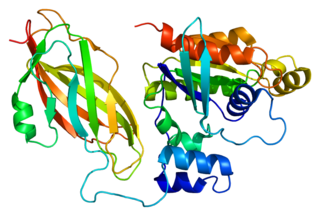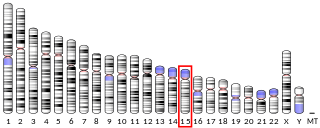| RHO protein GDP dissociation inhibitor | |||||||||
|---|---|---|---|---|---|---|---|---|---|
 Structure of RHO guanine nucleotide dissociation inhibitor. [1] | |||||||||
| Identifiers | |||||||||
| Symbol | Rho_GDI | ||||||||
| Pfam | PF02115 | ||||||||
| InterPro | IPR000406 | ||||||||
| SCOP | 1rho | ||||||||
| SUPERFAMILY | 1rho | ||||||||
| OPM superfamily | 91 | ||||||||
| OPM protein | 1qvy | ||||||||
| |||||||||
RHO protein GDP dissociation inhibitor of Rho proteins (rho GDI), regulates GDP/GTP exchange.
The Rho family of GTPases is a family of small signaling G proteins, and is a subfamily of the Ras superfamily. The members of the Rho GTPase family have been shown to regulate many aspects of intracellular actin dynamics, and are found in all eukaryotic kingdoms, including yeasts and some plants. Three members of the family have been studied in detail: Cdc42, Rac1, and RhoA. All G proteins are "molecular switches", and Rho proteins play a role in organelle development, cytoskeletal dynamics, cell movement, and other common cellular functions.

Guanosine diphosphate, abbreviated GDP, is a nucleoside diphosphate. It is an ester of pyrophosphoric acid with the nucleoside guanosine. GDP consists of a pyrophosphate group, a pentose sugar ribose, and the nucleobase guanine.

Guanosine-5'-triphosphate (GTP) is a purine nucleoside triphosphate. It is one of the building blocks needed for the synthesis of RNA during the transcription process. Its structure is similar to that of the guanine nucleobase, the only difference being that nucleotides like GTP have a ribose sugar and three phosphates, with the nucleobase attached to the 1' and the triphosphate moiety attached to the 5' carbons of the ribose.
The protein plays an important role in the activation of the oxygen superoxide-generating NADPH oxidase of phagocytes. This process requires the interaction of membrane-associated cytochrome b559 with 3 cytosolic components: p47-phox, p67-phox and a heterodimer of the small G-protein p21Rac1 and rho GDI. [2] The association of p21rac and GDI inhibits dissociation of GDP from p21rac, thereby maintaining it in an inactive form. The proteins are attached via a lipid tail on p21rac that binds to the hydrophobic region of GDI. [3] Dissociation of these proteins might be mediated by the release of lipids (e.g., arachidonate and phosphatidate) from membranes through the action of phospholipases. [3] The lipids may then compete with the lipid tail on p21rac for the hydrophobic pocket on GDI.

A superoxide is a compound that contains the superoxide anion, which has the chemical formula O−
2. The systematic name of the anion is dioxide(1−). The reactive oxygen anion superoxide is particularly important as the product of the one-electron reduction of dioxygen O2, which occurs widely in nature. Molecular oxygen (dioxygen) is a diradical containing two unpaired electrons, and superoxide results from the addition of an electron which fills one of the two degenerate molecular orbitals, leaving a charged ionic species with a single unpaired electron and a net negative charge of −1. Both dioxygen and the superoxide anion are free radicals that exhibit paramagnetism.
NADPH oxidase is a membrane-bound enzyme complex that faces the extracellular space. It can be found in the plasma membrane as well as in the membranes of phagosomes used by neutrophil white blood cells to engulf microorganisms. Human isoforms of the catalytic component of the complex include NOX1, NOX2, NOX3, NOX4, NOX5, DUOX1, and DUOX2.

Phagocytes are cells that protect the body by ingesting harmful foreign particles, bacteria, and dead or dying cells. Their name comes from the Greek phagein, "to eat" or "devour", and "-cyte", the suffix in biology denoting "cell", from the Greek kutos, "hollow vessel". They are essential for fighting infections and for subsequent immunity. Phagocytes are important throughout the animal kingdom and are highly developed within vertebrates. One litre of human blood contains about six billion phagocytes. They were discovered in 1882 by Ilya Ilyich Mechnikov while he was studying starfish larvae. Mechnikov was awarded the 1908 Nobel Prize in Physiology or Medicine for his discovery. Phagocytes occur in many species; some amoebae behave like macrophage phagocytes, which suggests that phagocytes appeared early in the evolution of life.














